令和3年05月29日 土曜日号
“里山 平成6年”
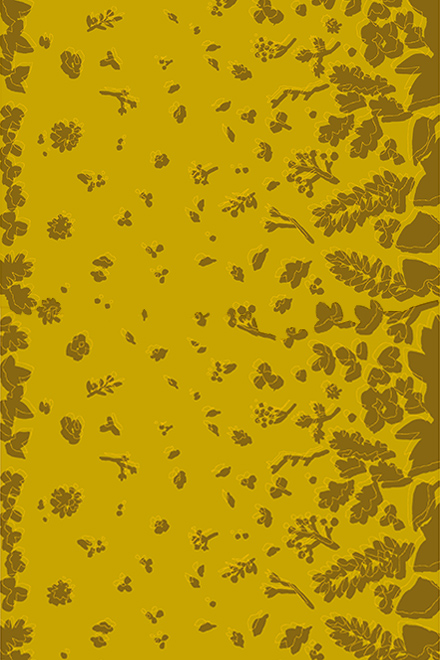
こもれびが気持のいい林の中に小道が続き
まわりには緑の草がおい茂っている
いろんな形の葉っぱや木の実が
目を楽しませてくれる
運がよければ
きのこや山菜にも出会えるかもしれない
心が解放され のびのびした自由な気持になって
元気がわいてくる
(脇阪 克二)
Rural Woodland (1994, by Katsuji Wakisaka)
Sunlight filtering down pleasantly through the trees
in the woodland, the pathway continues and
surrounded by lively green grasses.
Leaves and nuts of various shapes
are a feast for the eyes.
You might even find mushrooms and
edible wild plants if your are lucky.
Feeling relieved and free,
relax and become energetic.
| English translation by Karen Yiu |
Campagne boisée (1994, par Wakisaka Katsuji)
Les rayons de soleil traversant le feuillage des arbres d’une foret,
Un petit chemin se dessine, entourée d’herbe verte scintillante.
Les feuilles et fruits secs de toutes les formes
Sont un véritable spectacle vivant.
Vous pourriez même trouver des champignons et herbes sauvages
Comestibles avec un peu de chance.
Le coeur léger et libéré,
Détendez-vous et ressourcez-vous.
| Traduction française par Jean-Baptiste Fauvel |
里山(1994, 脇阪 克二)
陽光穿過樹葉的間隙灑下
林間小道往前延伸開去
周圍是繁密的綠草
各種形狀的樹葉和果實讓人愉快
運氣好還能遇見蘑菇和野菜
身處其中的我卸下枷鎖,身心放鬆
心情自由舒暢,充滿活力
| 中譯 : 李 瀟瀟 |
→こちらのテキスタイルデザイン商品
(Textile products with this pattern)
令和3年05月25日 火曜日号
“雪佳 海路 写し 令和三年”
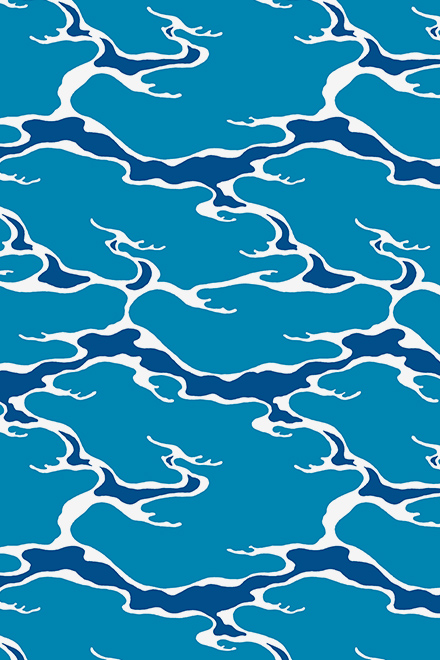

神坂雪佳は明治から
昭和のはじめまで活躍した絵師で
工芸品の図案も多く手がけている
この”海路”も 波と水をモチーフにした
図案集の中の1点の写し
人々に愛される絵や図案を描いた人で
京都の街で雪佳さんと呼ばれ
親しまれていた
(脇阪 克二)
Kamisaka Sekka - Kairo - recreation(2021, by Katsuji Wakisaka)
Kamisaka Sekka was a famous painter
in the late Meiji Era and early Showa Era in Japan.
A lot of exquisite patterns on craft works were created by him.
I recreated this pattern based on his work "Kairo",
which is from his anthology about wave and water patterns.
Sekka's paintings and the patterns he created has been highly appreciated.
In Kyoto, he was affectionately called
"Mr. Sekka" by the locals.
| English translation by Karen Yiu |
Voie Maritime de Kamisaka Sekka’s - Dupliqua(2021, par Katsuji Wakisaka)
Kamisaka Sekka fut un célèbre peintre de la fin de l’ère Meiji - début de l’ère Shōwa, connu pour ses motifs exquis.
J’ai créé un motif en m’inspirant de son oeuvre « Voie Maritime », issue de son anthologie sur les vagues et les motifs maritimes.
Grandement apprécié pour ses créations, Sekka était adoré des locaux qui l’appelaient affectueusement « Monsieur Sekka ».
| Traduction française par Jean-Baptiste Fauvel |
神坂雪佳 海路 再現(2021, 脇阪 克二)
神坂雪佳是日本明治末期昭和初期的著名畫家,
很多精美的工藝品圖案都是出自他之手。
「海路」就是再現了他的波浪與水紋圖案集中的一幅。
神坂雪佳的創作廣受好評,
在出生地京都,被當地人親切地喚作「雪佳先生」。
| 中譯 : 李 瀟瀟 |
→こちらのテキスタイルデザイン商品
(Textile products with this pattern)
令和3年05月22日 土曜日号
“さざ波 平成21年”
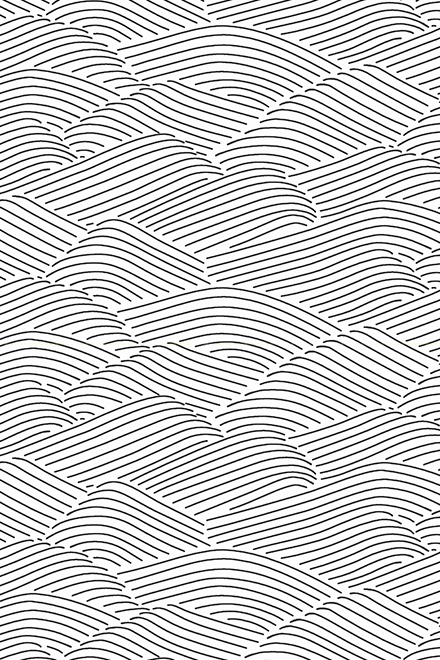
水は同じような模様を描いてただ流れているだけなのだが、
見ていて飽きることがない。
水音も耳に心地よい。
さざ波の立っているところでは音が少し高くなって、
波の模様も違ってくる。
川はいろいろに変化しながら悠久の時を刻んでいる。
(脇阪 克二)
Ripples (2009, by Katsuji Wakisaka)
I use the same stroke to present the flows of water,
but I never get tired of looking at them.
Water flow sounds pleasant and healing.
Pitch of the sound become a little bit higher when there are ripples
and the wavy pattern varies.
Ripples of river changes from time to time and are everlasting.
| English translation by Karen Yiu |
Ondulations (2009, par Katsuji Wakisaka)
J’utilise toujours les mêmes coups de crayons pour dessiner le courant de l’eau mais je ne me lasse jamais de les regarder.
Le bruit de l’eau est si plaisant et réparateur.
Ce bruit devient plus aigu quand il y a des ondulations, entrainant un changement de motifs.
Les ondulations des rivières changent de temps en temps, éternellement.
| Traduction française par Jean-Baptiste Fauvel |
漣漪(2009, 脇阪 克二)
水紋圖案只是簡單呈現水流不息的狀態,卻怎麽看都不會膩
水聲也讓人身心愉悅
漣漪蕩漾的部分流水聲比較高昂,波紋也有了變化
江河的流動抑揚頓挫,富有變化,銘刻著悠久的時間
| 中譯 : 李 瀟瀟 |
令和3年05月19日 水曜日号
“四君子 令和元年”
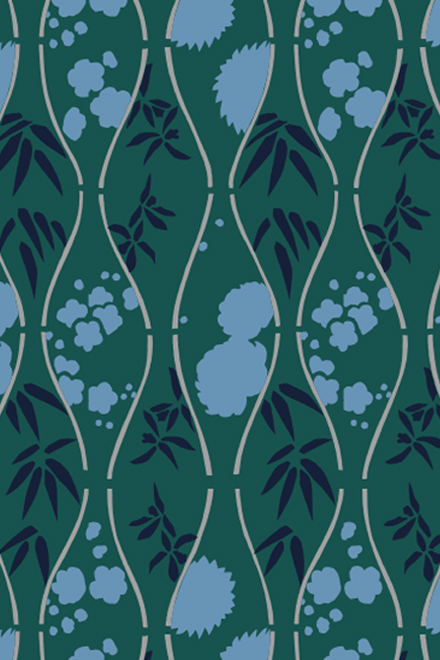
古来 中国で君子とは
徳と学識、礼儀を備えた
人を指してきた。
蘭、竹、菊、梅の4つの植物の
特徴が君子の特性と
似ていることから
文人画の代表的な素材となった。
その4つの植物を
シンプルなシルエットで表現し
すっきりと仕上げた。
(脇阪 克二)
Four Junzi (Shikunshi) (2019, by Katsuji Wakisaka)
In China, knowledgeable people of virtue and courtesy
are called "Junzi"(Kunshi) since ancient times,
which means noble people.
As the characteristics of orchid, bamboo, chrysanthemum and plum
are similar to the personality of Junzi,
they became the representative plants
for paintings of literary artists.
I created this pattern by using simple silhouettes
of these four plants and
finished in a clear-cut manner.
| English translation by Karen Yiu |
Quatre Nobles Plantes(2019, par Katsuji Wakisaka)
Autrefois en Chine, le terme « Junzi »,
« homme noble », désigner les personnes
vertueuses, érudites et courtoise.
Illustrant à merveille les qualités de ces gentilshommes,
L’orchidée, le bambou, le chrysanthème et la prune
devinrent les plantes représentatives dans les peintures de lettrés.
J’ai simplifié ces quatre plantes pour créer un design épuré.
| Traduction française par Jean-Baptiste Fauvel |
四君子(2019,脇阪 克二)
古代中國所謂「君子」
指德才兼備的人
又因蘭、竹、菊、梅之特性與「君子」相似
於是這四種植物成爲了文人畫的代表主題
我將植物四君子的輪廓簡化
創作出這件筆致簡潔的「四君子」
| 中譯 : 李 瀟瀟 |
令和3年05月15日 土曜日号
“わらび 平成16年”
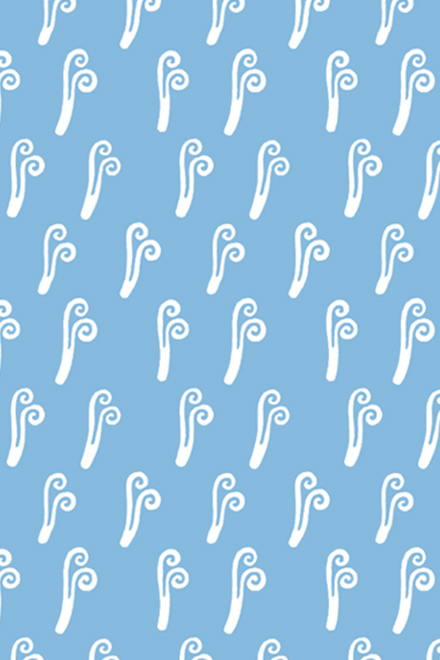
和菓子の中のお干菓子にあるわらびの形を
並べて作った模様。
お干菓子は単純な形でものの本質を
表しているところが面白い。
(脇阪 克二)
Warabi (2004, by Katsuji Wakisaka)
This is a pattern made by arranging the outline of warabi,
which is a traditional Japanese dried sweets (O-higashi).
O-higashi is interesting in that
it expresses the nature of things in a simple form.
| English translation by Karen Yiu |
Warabi (2004, par Katsuji Wakisaka)
Ce design représente le gâteau traditionnel
japonais gélatineux, appelé Warabi.
Les gâteaux japonais gélatineux représentent
L’essence même de la tradition japonaise,
Ce que je trouve très intéressant.
| Traduction française par Jean-Baptiste Fauvel |
蕨菜 (2004, 脇阪 克二)
我把日式茶點(干菓子)中常見的蕨菜造型排列平鋪,做成紋樣
干菓子用簡單的形狀表現事物的本質
這也是日式茶點有趣之處
| 中譯 : 李 瀟瀟 |
令和3年04月25日 日曜日号
“光琳 燕子花図屏風 写し 令和三年”


光琳は江戸時代の代表的な絵師であり
俵屋宗達の影響を
強く受けた琳派の継承者
この有名な燕子花図は
図案化されたモチーフを
くりかえし使いながら
燕子花の自然で生き生きとした
感じが表現されている
何百年という時を超えて
色あせぬ美しさ、新しさが
この絵にはある
古典として残っているというのは
そういうことなのだ
(脇阪 克二)
Korin Ogata - Irises folding screens - recreation(2021, by Katsuji Wakisaka)
Korin was one of the most famous painters of the Edo period.
He was strongly influenced by Tawaraya Sotatsu and
became the heir to the Rimpa school.
This famous painting of the Irises,
with its repeated use of stylised motifs and color pigments,
captures the natural vibrancy of the flower.
There is a beauty and novelty in this painting
that has not faded over hundreds of years.
This is what it means to be a classic.
| English translation by Karen Yiu |
Paravents d’Iris d’Ogata Korin - Dupliqua(2021, par Katsuji Wakisaka)
Korin fut l’un des plus célèbres peintres de l’ère Edo.
Grandement influencé par Sotatsu Tawaraya,
Il devint le successeur de l’école Rimpa.
Cette fameuse peinture d’Iris,
Avec ses motifs stylisés et ses couleurs à pigments,
Capture vitalité naturelle de cette fleur.
La beauté et l’innovation de cette oeuvre
Restent intactes malgré les centaines d’années passées.
Voilà l’essence même de ce qu’est un classique.
| Traduction française par Jean-Baptiste Fauvel |
尾形光琳 燕子花圖屏風 再現(2021, 脇阪 克二)
尾形光琳是日本江戶時代的代表畫家,
深受琳派的始創人俵屋宗達的影響,
是造型藝術流派「琳派」集大成者。
光琳創作的這幅有名的「燕子花圖」
反覆使用花木型紙的圖案,
將燕子花的自然姿態展現得淋漓盡致。
歲月流逝幾百年,
其豊富裝飾性與設計新潮感絲毫不減。
這大概就是古典之最好詮釋了吧。
| 中譯 : 李 瀟瀟 |
→こちらのテキスタイルデザイン商品
(Textile products with this pattern)
令和3年03月25日 木曜日号
“乾山 梅花散文蓋物 写し 令和二年”


尾形光琳の弟で
陶芸家 乾山作の梅文様の写し
シンプルな同じ形の梅の花を
重ねただけの模様だが
江戸時代の作だと思われない程
かわいくモダンなデザイン
使いやすくあきがこない
テキスタイルデザインの模範のような柄
(脇阪 克二)
Covered box with a design of plum blossoms - recreation(2020, by Katsuji Wakisaka)
A recreation of a plum blossoms design by
the ceramic artist Kenzan, brother of Kourin Ogata.
It is a simple design of
overlapping the plum blossoms patterns,
but the design is so pretty and modern that
it is hard to believe it was made in the Edo period.
It is a model of textile design
that is easy to use and never get bored.
| English translation by Karen Yiu |
Boite à motifs de fleurs de pruniers - Dupliqua(2020, par Katsuji Wakisaka)
Un duplicata de fleurs de pruniers designé
Par l’artiste en céramique Kenzan, frère de Kourin Ogata.
Il s’agit d’un design simple, une superposition de motifs de fleurs de pruniers;
Un superbe design moderne, qu’il est difficile d’imaginer aussi ancien que la période d’Edo au 17ème siècle.
Principalement utilisé comme design textile,
il est facile à exploiter et on ne s’en laisse jamais.
| Traduction française par Jean-Baptiste Fauvel |
乾山 梅花散紋陶盒 再現(2020, 脇阪 克二)
我描摹了日本江戶時代的陶藝家————
尾形乾山(著名畫家尾形光琳的弟弟)創作的梅花紋
這個由形狀簡單的梅花重叠組成的紋樣
可愛又充滿了現代的氣息
完全看不出是300年前江戶時代的作品
沒有時光的痕跡、百看不膩、還可以用在各種地方的圖案
堪稱是織物紋樣設計的典範
| 中譯 : 李 瀟瀟 |
→こちらのテキスタイルデザイン商品
(Textile products with this pattern)
令和3年02月27日 土曜日号
“北斎 神奈川沖浪裏 写し 令和二年”
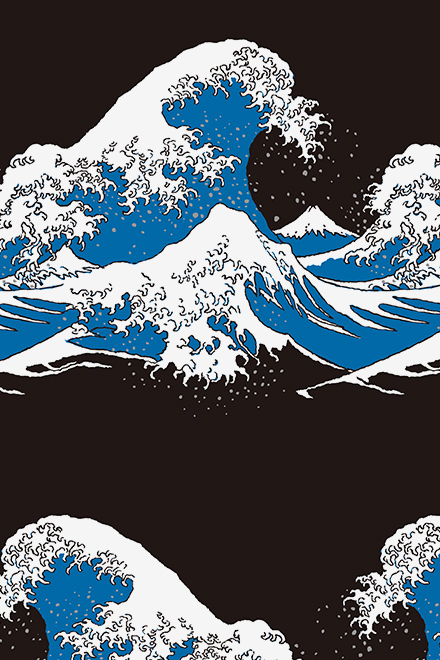

世界で最も高く評価されている
日本の美術は何かというと
浮世絵だろうと思う
その中でも北斎のこの浪の絵は
最も人気のあるもののひとつだろう
このダイナミックな浪の動き
白い波頭がおそいかかってくる
表現は人々の心をとらえてはなさない
北斎は90才で死ぬまで
現役の絵師として活躍した人であった
(脇阪 克二)
Hokusai - The Great Wave of Kanagawa - recreation(2021, by Katsuji Wakisaka)
I think one of the most highly regarded
Japanese art forms in the world is Ukiyo-e.
Hokusai's paintings of the the waves
should be the most iconic one among them.
The dynamic movement of the waves
with the white crests,
captures one's heart and never lets go.
Hokusai was an active artist and painter
until his death at the age of 90.
| English translation by Karen Yiu |
La Grande Vague de Kanagawa par Hokusai - Dupliqua(2021, par Katsuji Wakisaka)
Je pense que l’art japonais le plus
Reconnu au monde est l’Ukiyo-e.
L’estampe des vagues de Hokusai
Est sûrement la plus iconique d’entre elles.
Le dynamisme des vagues et de ses
Crêtes blanches est à couper le souffle.
Hokusai restera un artiste et peintre
En activité jusqu’à sa mort à l’âge de 90 ans.
| Traduction française par Jean-Baptiste Fauvel |
北齋之神奈川沖浪裏 再現(2021, 脇阪 克二)
浮世繪無疑是世界評價最高的日本美術
在所有舉世聞名的浮世繪作品中
這幅《神奈川沖浪裏》算得上首屈一指
巨浪翻滾的躍動感
白色浪尖飛散襲來
畫面充滿張力,直擊人心
葛飾北齋享年90歲
到離世爲止,從未停止過作畫
| 中譯 : 李 瀟瀟 |
→こちらのテキスタイルデザイン商品
(Textile products with this pattern)
令和3年02月13日 土曜日号
“おはじき重ね 平成20年”
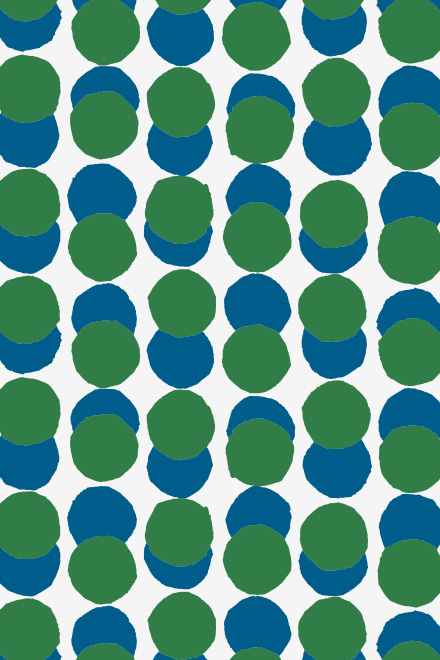
SOU・SOUの人気柄の一つ、
おはじきを重ねてみようということからうまれた模様。
多くの人に好まれる水玉。
かわいくてとがってなくて、安心して感情移入ができるのだと思う。
(脇阪 克二)
Marbles Layering (2008, by Katsuji Wakisaka)
One of the SOU・SOU's popular patterns.
It was born from the idea of layering and stacking the playing marbles.
Finished with polka dots-like pattern which is loved by many people.
It is cute and not being sharp in shape,
that can easily connect to your emotion.
| English translation by Karen Yiu |
Couches de billes (2008, par Katsuji Wakisaka)
Une des créations de SOU・SOU les plus connues,
Née du concept d’empiler des billes les unes sur les autres,
Et d’une finition de motif à pois, tant apprécié à travers le monde.
Très mignon et doux, ce design apaise et fascine.
| Traduction française par Jean-Baptiste Fauvel |
彈珠重疊(2008, 脇阪 克二)
我把SOU・SOU的人氣紋樣『彈珠』重叠排列,
創作除了這塊布料紋樣。
圓點圖案可愛而沒有棱角,不尖銳,讓人安心。
這或許也是很多人喜歡圓點的原因吧。
| 中譯 : 李 瀟瀟 |
→こちらのテキスタイルデザイン商品
(Textile products with this pattern)
- コメント
-
おはじきの色を赤と黄に置き換えると、春節の飾りの主役、ランタンに見えてしまうのは、この時期ならのことでしょうか?そうしたタイミングに重なると、テキスタイルに無限の広がりを感じて、纏っていても、使っていても心が弾みますね。これは、テキスタイルと色彩の持つ素敵な魔力かも知れません。
温故知新様
コメントいただき、ありがとうございます。
確かに、赤と黄色に置き換えると春節のときのランタンのようですね。
テキスタイルの持つ形やライン、そして色彩の重なりに、わたしたちの内面にあるものが刺激されて、それがタイミングによって好きという気持ちや心地よさ、楽しさにつながるのかなと思ったりします。なので、日々、SOU・SOUのテキスタイルデザインに触れていても、新しい発見や好きが見つかります。
- 最近書いた記事
- 関連記事
-
令和3年02月06日 土曜日号
“つぎはぎ細工 令和元年”
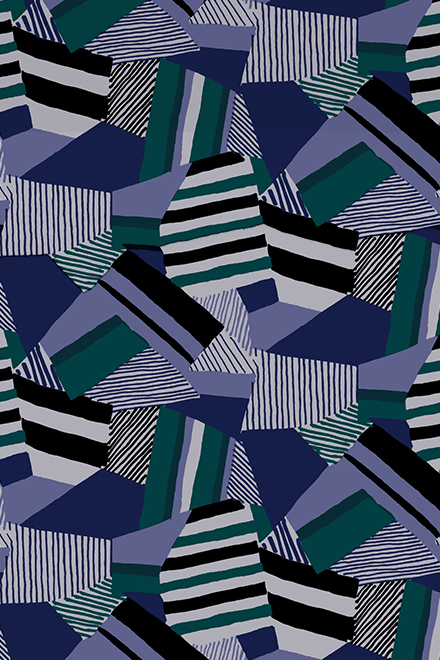
つぎはぎしてつくった模様
無秩序に形がぶつかり
ダイナミックな空間が生まれている
なんでも あまりまとまりすぎると
面白味がなくなる
(脇阪 克二)
Patchwork (2019, by Katsuji Wakisaka)
Patching up different patterns
randomly without any orders.
It forms a dynamic space.
Anything that is over-organized
will become boring.
| English translation by Karen Yiu |
Patchwork (2019, par Katsuji Wakisaka)
Motif en forme de patchwork.
D’une forme chaotique nait
Un monde dynamique.
Peu importe le domaine,
Il ne faut pas trop ordonner,
Au risque d’en perdre tout intérêt.
| Traduction française par Jean-Baptiste Fauvel |
拼接細工(2019, 脇阪 克二)
將圖案拼接,做成新的印花
幾何圖形無秩序地排列重叠
營造出動態的空間
有種隨性創作的趣味性
凡事大都如此
太過規整,反而變得無趣
| 中譯 : 李 瀟瀟 |
→こちらのテキスタイルデザイン商品
(Textile products with this pattern)
令和3年02月03日 水曜日号
“ほのか 平成2年”
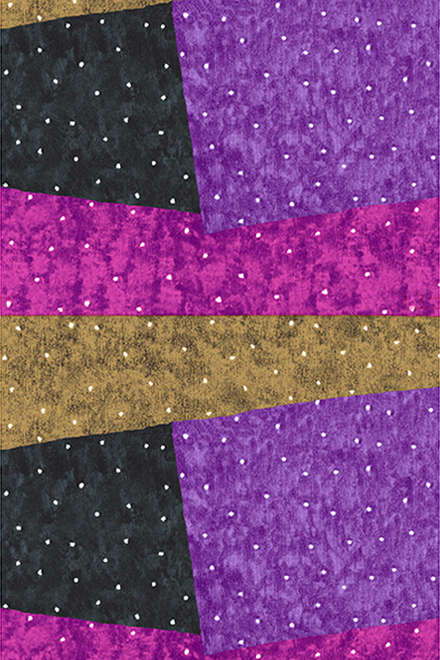
光、色、香りなどが
ほのかに感じられてくる
明瞭でないことが
想像力をふくらませる
ローソクのおだやかな光の中で
静かで濃密な時が流れていく
(脇阪 克二)
Slightly (1990, by Katsuji Wakisaka)
Light, color and scent etc.,
those you can merely feel.
They are vague
but have the power to let your imagination fly freely.
In the gentle and serene light of the candles,
time flows quietly and densely.
| English translation by Karen Yiu |
Faiblement (1990, par Wakisaka Katsuji)
La lumière, les couleurs, les odeurs
me parviennent faiblement.
Les choses peu évidentes
nourrissent mon imagination.
Dans la faible lueur d’une bougie,
le temps si lourd s’écoule silencieusement.
| Traduction française par Jean-Baptiste Fauvel |
朦朧(1990, 脇阪 克二)
光線、顔色、香氣等隱約浮現的狀態
那種曖昧不明的感覺最能引起人的遐想
我的這副創作表現的是
隱約又溫柔的燭光中
唯有時光靜謐流淌
| 中譯 : 李 瀟瀟 |
令和3年01月27日 水曜日号
“環繋ぎ矢車文 写し 令和二年”
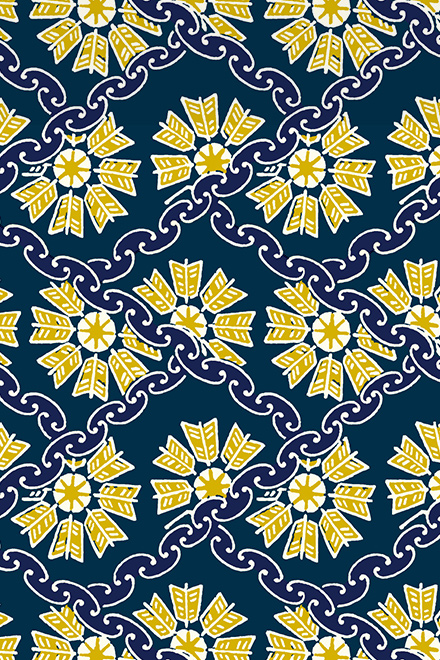

鯉のぼりの上でくるくると
まわっている矢車と輪っかを
つなぎ合わせた文様の写し
不思議な柄に見えるが
その時代の空気や人々の暮らしが
感じられる
人はそれぞれの時代の中を
生きていくしかない
その中で生まれてくるものがあり
残っていくものがある
そして今に生かされていくものがある
(脇阪 克二)
Continuation of arrow wheel - recreation(2021, by Katsuji Wakisaka)
This is the recreation of the pattern of
a spinning arrow wheel on top of the carp streamer.
The pattern may look strange
but you can feel the atmosphere
and the people's life of that period.
People have to keep on living in their own time.
In the midst of the time,
there are things that are born,
things that remain
and things that still exist and are used today.
| English translation by Karen Yiu |
Moulinette à anneau - Dupliqua(2021, par Katsuji Wakisaka)
Ce design représente un assemblage
entre un anneau et une moulinette,
Que l’on retrouve sur les drapeaux en forme
de carpes pour la fête des enfants.
Il peut paraitre singulier mais
Il illustre parfaitement l’ambiance de cette période,
Ainsi que la vie quotidienne des japonais.
Peu importe les période, la survie est maître d’ordre.
En ces périodes difficiles naissent des choses,
Qui parfois subsistent et sont encore utilisées aujourd’hui.
| Traduction française par Jean-Baptiste Fauvel |
圓環風車紋 再現(2021, 脇阪 克二)
鯉魚旗上方的小風車(插滿箭矢的車輪狀物)
與圓環相連,組成了這個古典紋樣
乍看之下神秘莫測的圖案
充滿了那個時代的氛圍和平民生活的氣息
人無法選擇自己生活的時代
每個時代孕育新的事物,留下一些
上一個時代承繼給我們的東西
如今依然充滿生命力
| 中譯 : 李 瀟瀟 |
→こちらのテキスタイルデザイン商品
(Textile products with this pattern)
令和3年01月23日 土曜日号
“花影 令和元年”

花と線の組み合せなのだが
花のシルエットが影のように
浮かび上がって見える。
少しの表現の工夫で
新しい感じが出るものだ
作ることの面白さだと思う
(脇阪 克二)
Shadow of Flowers(2019, by Katsuji Wakisaka)
It is a combination of just flowers and stripes
but the silhouettes of the flowers
look like some floating shadows in this pattern.
A brand new feeling is brought out
by further elaborating on an expression,
I think it is the interesting part of drawing patterns.
| English translation by Karen Yiu |
Hanakage (2019, par Katsuji Wakisaka)
Un ensemble de fleurs et de lignes donne forme à une ombre en forme de fleur.
Avec quelques coups de crayons, un nouveau motif est né.
En ceci réside la joie de créer.
| Traduction française par Jean-Baptiste Fauvel |
花影(2019, 脇阪 克二)
花與線條組合而成的圖案
花的輪廓如影子,漂浮游弋
在表現手法上稍微下功夫
就會創作出全新風格的圖案
對我來説,這就是布料紋樣設計的魅力所在
| 中譯 : 李 瀟瀟 |
→こちらのテキスタイルデザイン商品
(Textile products with this pattern)
令和2年12月26日 土曜日号
“金銀襴緞子等縫合せ 写し 令和二年”


上杉謙信で有名な上杉家伝来の
衣裳の中の一点
直線で切られた幾何的な形の
布地が縫い合わされた着物
戦国時代のものとは思えない
ポップな着物
その写しとして現代の衣裳に
活かしたい
(脇阪 克二)
Patchwork kimono of Uesugi Kenshin family - recreation
(2021, by Katsuji Wakisaka)
It is one of the traditional costumes from
the famous Uesugi Kenshin family,
A patchwork kimono sewn with
geometrically shaped fabrics that cut in straight lines
The pop and colorful design
makes it does not look like a kimono from the Sengoku Period
Hope I can make use of the replication
of the design in modern costumes
| English translation by Karen Yiu |
Motif de kimono de la famille Uesugi Kenshin - Dupliqua
(2021, par Katsuji Wakisaka)
Il s’agit d’un des costumes traditionnels
de la fameuse famille Uesugi Kenshin.
Un motif de kimono cousu avec des tissus
découpés en différentes formes géométriques.
Ce design pop et coloré ne donne pas l’impression
D’avoir à faire à un Kimono du 15ème siècle.
J’espère que sa réutilisation collera bien
Aux costumes modernes de notre époque.
| Traduction française par Jean-Baptiste Fauvel |
金銀襴緞子等縫合胴服 再現(2021, 脇阪 克二)
這是以武將上杉謙信爲代表的上杉家族流傳下來的一種服飾紋樣
這件將將呈直線切割的幾何圖形的布料拼接起來縫製而成的和服
充滿了現代感,難以相信是16世紀日本戰國時代的設計
我將它描摹下來,希望可以延用在現代服飾紋樣中
| 中譯 : 李 瀟瀟 |
→こちらのテキスタイルデザイン商品
(Textile products with this pattern)
令和2年12月16日 水曜日号
“じどうしゃ 令和元年”
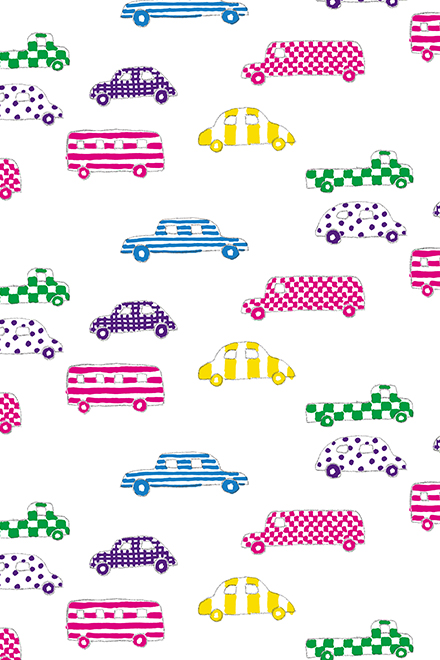
子供のころから自動車が好きだった
乗ることより形に魅きつけられていた
フィンランドに住んでいた
1960~70年代には
昔のフランスやイタリア
又、東欧やロシアの車も走っていて
それぞれの形に独自性があり
いっそう魅かれていった
その国の文化がそれぞれの形を
作り出していて
見ているだけで楽しかった
今はどこの国の車も
似たような形になってきて
昔のように僕をワクワク
させてくれなくなった
(脇阪 克二)
Cars(2019, by Katsuji Wakisaka)
I've loved cars since I was small.
I was fascinated by their shapes rather than having a ride on them.
When I lived in Finland
in the 60s to 70s,
I was attracted by the uniqueness in shape
of French, Italian, Eastern Europe and
Russian made old-fashioned cars
that still running on the road.
It was fun to just look at them
and see the peculiarities of each culture.
Cars nowadays look more or less the same
even they are made from different countries.
They don't excite me as much as
they used to.
| English translation by Karen Yiu |
Voiture (2019, par Katsuji Wakisaka)
J’aime les voitures depuis que je suis petit.
J’ai été attiré plus par leurs formes que leurs mouvements.
Quand j’habitais en Finlande dans les années 60-70, il y avait de vieilles voitures françaises, italiennes, scandinaves et russes.
Chacune avait sa forme propre, si élégante.
C’était divertissant de simplement les regarder et d’y voir les particularités de chaque culture.
Les voitures d’aujourd’hui se ressemblent plus ou moins, me laissant complètement indifférent en comparaison d’autrefois.
| Traduction française par Jean-Baptiste Fauvel |
汽車(2019, 脇阪 克二)
我從小就很喜歡汽車。
倒也不是喜歡乘坐,
而是被它們可愛的外形吸引。
我1960~70年代曾在芬蘭生活,
北歐的公路上馳騁著各式東歐和俄羅斯產的汽車,
形狀獨特,深深吸引我的目光。
那些國家的文化,融入各種汽車的形狀,很有意思。
但是現在世界上的汽車外觀都很相似,沒有了個性,
很難讓我再湧起當年對格式汽車的熱愛了。
| 中譯 : 李 瀟瀟 |
→こちらのテキスタイルデザイン商品
(Textile products with this pattern)
令和2年12月01日 火曜日号
“鶴 令和二年”


昔 日本の広い地域にいたと
思われる鶴だが
現在 数ヵ所に生息し
あるいは飛来してくる
昔話によく登場し
鶴は千年 亀は万年のたとえのように
長寿の鳥として
おめでたいものとされてきた
折鶴 千羽鶴としても親しまれてきている
白い雪の中
白と黒の鶴が大きな羽根をひろげ
舞うようにたわむれている姿は
夢のように美しい
(脇阪 克二)
Crane(2020, by Katsuji Wakisaka)
Cranes have been found all around Japan.
But nowadays they only inhabit few places or migrate from other areas.
Cranes appear in old tales, and are emblems of longevity.
There is a saying "Cranes live a thousand years, turtles live ten thousand years."
Orizuru (folded paper cranes) and Senbazuru (One thousand cranes) are very familiar to Japanese people.
Have you ever seen cranes with white and black wings are frolicking in the snow?
It looks too gorgeous to be true.
| English translation by LI XIAOXIAO |
Grue(2020, par Katsuji Wakisaka)
Les grues sont très nombreuses au Japon.
Mais de nos jours, elles habitent seulement dans quelques régions ou migrent vers d’autres pays.
Les grues sont souvent citées dans les contes et sont symbole de longévité.
Il y a un diction qui dit: « Les grues vivent des milliers d’années,
les tortures des dizaines de milliers d’années.
Orizuru (Origami sous forme de grues) and Senbazuru (Les milles grues)
sont des pratiques très répandues au Japon.
Avez-vous déjà eu la chance de voir des grues aux ailes blanches et noires scintillées dans la neige.
Cela semble trop beau pour être vrai.
| Traduction française par Jean-Baptiste Fauvel |
鶴(2020, 脇阪 克二)
鶴曾存在於日本多處,
而現在僅存爲數不多的栖息地了,
還有一部分是從別的地方遷徙而來的。
鶴出現在許多神話傳説中,
所謂“千年鶴,萬年龜”,鶴象徵著長壽吉祥,
紙鶴、千紙鶴等也爲人們所熟知。
天地一片白雪中,鶴張開它黑白色的翅膀,
翩翩起舞,嬉戲追逐,
那場景如夢境般引人入勝。
| 中譯 : 李 瀟瀟 |
→こちらのテキスタイルデザイン商品
(Textile products with this pattern)
令和2年10月31日 土曜日号
“鹿 令和二年”


鹿と言えば
僕は奈良が浮かんでくる
広い奈良の緑の中を
鹿は歩きまわり
走ったり ねそべったりしている
人をおそれず たわむれてくるし
鹿せんべいを持っていると追いかけられる
人と野性どうぶつの距離がこんな近いことも珍しい
(脇阪 克二)
Deer(2020, by Katsuji Wakisaka)
When we talk about shika deer in Japan,
Nara area occurs to my mind.
In the vast greenery of the city,
Nara deer roam and run freely around,
lie down and being relaxed and leisurely,
They are not afraid of humans at all, and always
chasing people down for deer-crackers.
It is unusual to see that wild animals are so close to humans.
| English translation by LI XIAOXIAO |
Daim(2020, par Katsuji Wakisaka)
Quand on parle de daim au Japon,
Je pense directement à Nara.
Dans la vaste verdure de la ville,
Les daims se promènent, courent
Et se prélassent dans les prés.
Sans attaquer les passants,
ils s’amusent entre eux.
Quand on tient des biscuits pour daims,
Ils viennent nous poursuivre.
Que c’est rare de voir des êtres humains
Et des animaux sauvages si proches.
| Traduction française par Jean-Baptiste Fauvel |
鹿(2020, 脇阪 克二)
提到鹿,我腦海中首先浮現出奈良的鹿
在奈良廣袤的綠野中
鹿優雅漫步,肆意奔跑,或閑適地側躺
它們不畏懼人類,自在地與人嬉鬧
甚至追逐拿著鹿仙貝的游客
除了鹿,很難有其他野生動物
能與人保持這樣的近距離感了
| 中譯 : 李 瀟瀟 |
令和2年10月07日 水曜日号
“あやなす 平成3年”
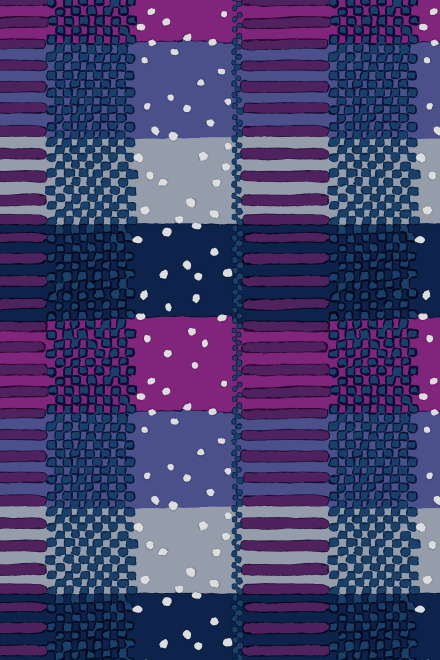
水玉、市松、縞を
格子に組み込んで
あやなす模様の世界
何でもない柄だが
その何でもなさが
安心感と充実感を
与えてくれる
(脇阪 克二)
Ayanasu(1991, by Katsuji Wakisaka)
A splendid world that made by
the combination of polka dots,
checks, stripes and lattices patterns.
It is an ordinary pattern
but its inexplicable attractiveness
gives us a feeling of calm and fullness.
| English translation by Karen Yiu |
Resplendissant - Ayanasu(1991, par Katsuji Wakisaka)
Un monde de motifs resplendissants,
composé de motifs à pois, à damiers et à rayures.
Il ne s’agit pas de motifs complexes mais
leurs simplicités m’apportent un sentiment de calme et de plénitude.
| Traduction française par Jean-Baptiste Fauvel |
斑斕紋樣(1991, 脇阪 克二)
圓點、市松、條紋
把這些形狀框成一格一格
拼出斑斕的紋樣
看上去并不具像
卻給人無以名狀的
安心感和充實感
| 中譯 : 李 瀟瀟 |
→こちらのテキスタイルデザイン商品
(Textile products with this pattern)
令和2年10月03日 土曜日号
“家紋 平成17年”
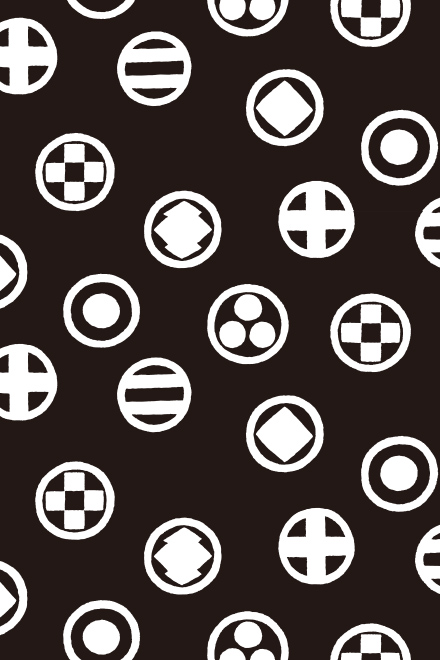
日本の家紋はセンスがいいし、
かっこいいと思う。
これ以上出来ないというところまで
モチーフを凝縮し単純化している。
その中に美しさ、力強さ、
しゃれっ気、遊び心などが息づいている。
ひとつひとつの家紋が個性的で誇り高い。
(脇阪 克二)
Family Crest (2005, by Katsuji Wakisaka)
Japanese family crest designs
are cool and have good sense of style.
They are the results of condensation and simpification of motifs
which up to the maximum degree.
We can find the beauty, strength,
desire of stylishness and sense of humor in it.
Every crest design is unique and something to be proud of.
| English translation by Karen Yiu |
Sceau familial (2005, par Katsuji Wakisaka)
Je trouve que les sceaux familiaux
japonais sont très stylés et très chics.
Les motifs sont condensés et simplifiés
jusqu’au maximum.
Ils ont en eux beauté, force, élégance et imagination.
Chaque sceau est original, dont on peut être fier.
| Traduction française par Jean-Baptiste Fauvel |
家紋(2005, 脇阪 克二)
日本的家紋格調高雅又時髦
家紋的設計將圖案精簡到極緻
蘊藏著美感,力道,裝飾感和趣味性
每一個家紋設計都獨創一格,格調高雅
| 中譯 : 李 瀟瀟 |
令和2年09月30日 水曜日号
“花唐草 平成30年”
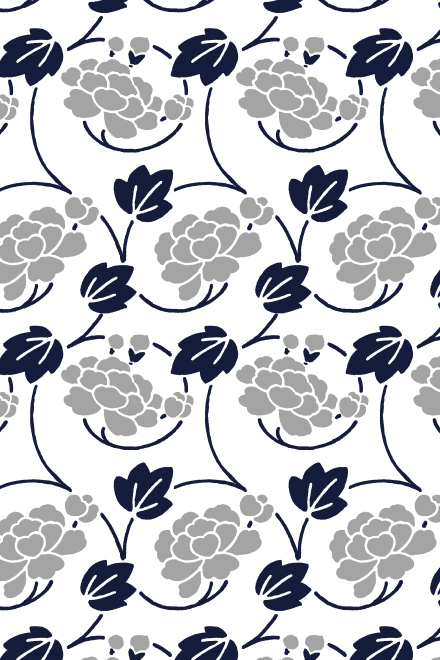
唐草模様は昔から
世界中にあり愛されてきた
これは淡白でシンプルなもの
くるりと巻いた唐草の動きと
花と葉の表情だけで
すっきりと仕上げた
(脇阪 克二)
Flower Arabesque Pattern(2018, by Katsuji Wakisaka)
Arabesque patterns have been loved
by people around the world over centuries.
It is a simple and faithful design
which I illustrated only the movement of the curled arabesques and
the expression of flowers and leaves,
and it is neatly done.
| English translation by Karen Yiu |
Arabesque florale(2018, par Katsuji Wakisaka)
Le motif d’arabesque floral est depuis
toujours aimé à travers le monde entier.
Le mouvement des volutes si simples et si candides
représente fidèlement les différents aspects des fleurs.
| Traduction française par Jean-Baptiste Fauvel |
花唐草(2018, 脇阪 克二)
唐草圖案(蔓藤花紋)一直廣為世界各地的人們所喜愛
我畫的這唐草恬淡又簡單
蔓藤彎曲的動態,配合花與葉
不熱烈不濃郁,簡樸而雅淡
| 中譯 : 李 瀟瀟 |
→こちらのテキスタイルデザイン商品
(Textile products with this pattern)






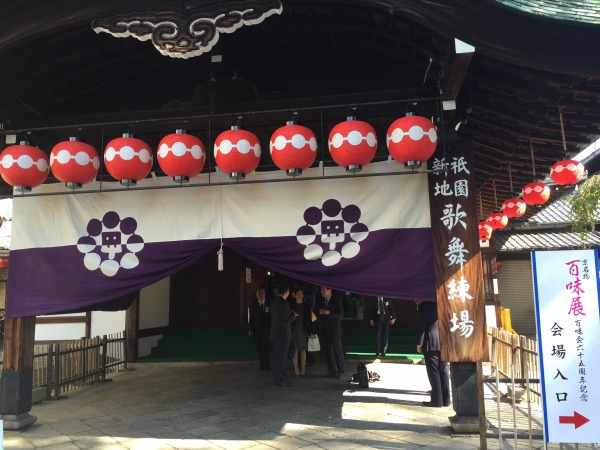

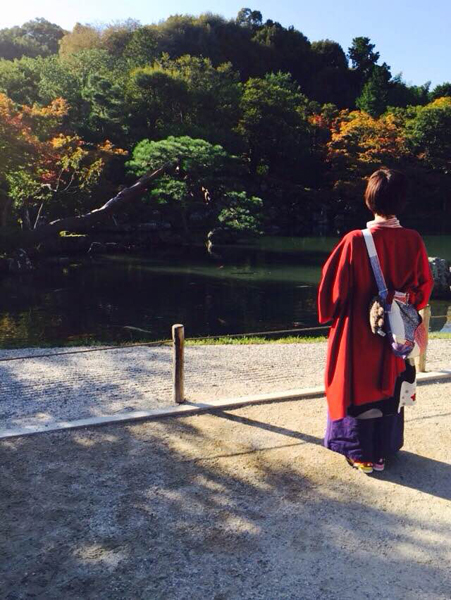
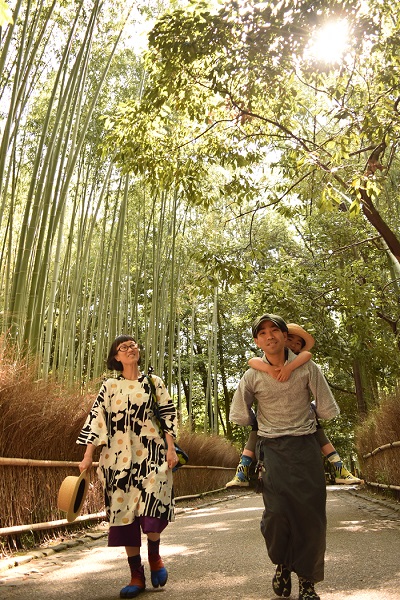

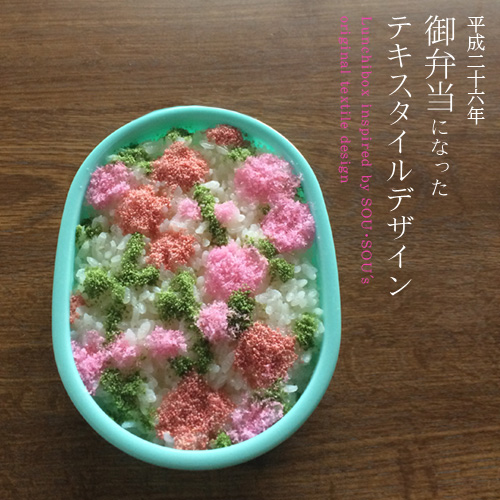
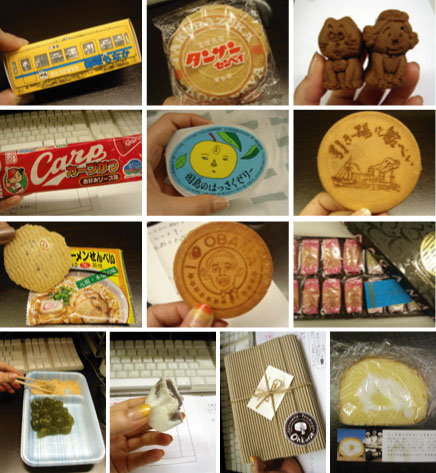
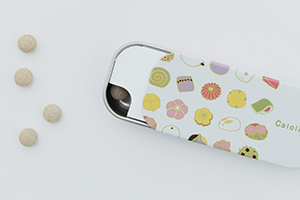
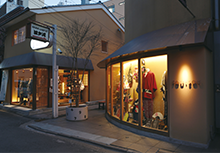
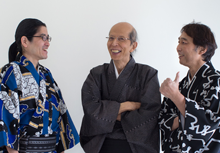

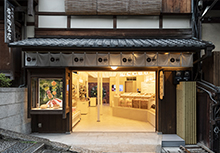

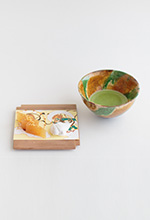
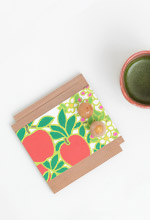
 お問い合わせ窓口
お問い合わせ窓口
これ、欲しいです・・。
色もデザインもパッと魅かれました。
手ぬぐい、足袋下、生地、有りませんか~?
よっ!様
コメントいただき、ありがとうございます。
「四君子」のテキスタイルデザインの商品につきまして、
あいにく現在、手ぬぐい・足袋下・テキスタイル計り売りの取り扱いはなく、現時点で今後の販売予定はございません。
誠に申し訳ございませんが、何卒ご了承のほどお願い申し上げます。